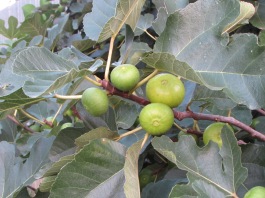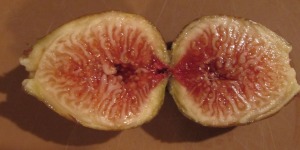
 Southern springtime brings many botanical treasures, which are usually proudly displayed in orderly fashion in well-kept garden beds. However, the jewels I cherish most are found along overgrown fence lines and creeping into unkempt pastures. I’m talking about wild blackberries or dewberries or whatever you would like to call species of the Rubus genus. In early spring, X’s can be marked on treasure maps when a profusion of white flowers bloom almost synchronously on two-year old canes. After this display, the plants blend into the background greenery nearly lost and relegated to the shadows of honeysuckle and other trees that finally decide to leaf out. Persistent foragers are rewarded several weeks later when ripening berries can be seen in flashes of red, purple and ultimately black.
Southern springtime brings many botanical treasures, which are usually proudly displayed in orderly fashion in well-kept garden beds. However, the jewels I cherish most are found along overgrown fence lines and creeping into unkempt pastures. I’m talking about wild blackberries or dewberries or whatever you would like to call species of the Rubus genus. In early spring, X’s can be marked on treasure maps when a profusion of white flowers bloom almost synchronously on two-year old canes. After this display, the plants blend into the background greenery nearly lost and relegated to the shadows of honeysuckle and other trees that finally decide to leaf out. Persistent foragers are rewarded several weeks later when ripening berries can be seen in flashes of red, purple and ultimately black.


Like all precious treasures, blackberries are heavily guarded by barbed brambles. Personally, I’m as at home in a briar patch as Br’er Rabbit and won’t let the snags and sticks of the berry canes keep me from my delicious prize. I’ll endure encounters with bugs of all kinds- mosquitos, fire ants, chiggers, ticks, spiders, and stinging caterpillars. Larger animals will elicit a stronger startle response from me- the flutter of birds, the scurry of rabbits or field mice, the scamper of feral cats and even once the bustle of an extremely near-sighted armadillo. There is only one thing that will cause my stomach to pucker and lead me to call it a day on blackberries- the slither of a snake. This time of year in Louisiana, a snake encounter is a statistical certainty during blackberry picking. Even if I don’t see them, I accept that they are there. I will even go so far as to acknowledge their right to exist in my berry patches.* I would just never like to confront them. So, I tromp heavily in boots and use a cane knife to shake the briars a bit before plunging into them up to my elbows. When I do happen upon the fearsome reptiles, the encounters are never lethal despite my cane knife, but I do lose the nerve for berry-picking for the day.

Blackberry bucket Credit: Johnna Roose

Dewberry canes Credit: Johnna Roose
The internet tells me that there are some cultivated varieties without thorns at all that can be grown orderly-like vineyard-style, but it is difficult for this southern girl to reason why you would take the effort to tend such plants when wild varieties produce such deliciousness for free with no aid from a gardener. Nevertheless, several links at the end of this post provide details on blackberry cultivation if you are not a wild-blackberry purist like me. For many wild varieties, some have prominent prickles on the stems and spines on the leaves, while others have additional sharp hairs along their stems. This brings us to an issue of nomenclature dear to some people’s hearts. (No, I’m not talking about thorns vs. prickles vs. spines. I’ve covered that previously.) I’m talking about blackberries vs. dewberries. While blackberries may be an umbrella term for this type of fruit, I’ve noticed that southerners prefer to make the distinction when dewberries are what you are really talking about. I am an equal opportunity berry picker and eater, but here are the highlights when it comes to dewberries. Dewberries, Rubus trivialis**, are slightly larger than most wild blackberries and ripen a few weeks earlier. Their canes are red and contain hairy bristles in addition to prickles, while blackberry canes are green and lack the extra layer of hairy bristles. Blackberry plants have a more upright form, while the dewberry canes bend and creep along the ground with tips that root easily to conquer more ground.

Blackberry, an aggregate fruit of drupelets.
Credit: Johnna Roose
While we’re on the subject of nomenclature, there’s something more fundamental we need to talk about. //looks over both shoulders and whispers// They aren’t really berries, botanically speaking. Yes, it’s true. This is another instance when common or culinary usage of a term differs from the strict scientific definition. In the world of plant science, a simple berry is a fruit containing the seeds and pulp from a single ovary. So, things like blueberries and cranberries are examples of fruit both commonly and scientifically referred to as berries. Other believable berries include grapes and currants. You may not believe me, but based on the botanical definition avocados, tomatoes and watermelons are also berries. Incidentally, strawberries are not berries either, but that is a subject for another post. Blackberries, dewberries and raspberries are aggregate fruit, in which each tiny round fleshy piece (a drupelet) is derived from a separate ovary in the flower but bound together in the form we commonly refer to as a berry. Don’t worry, I’ll still call them blackberries because blackaggregatefruit just doesn’t have the same ring to it.
After all, when it comes to food plants, being scientifically accurate takes a backseat to culinary use. ‘Berry cobbler’ just triggers a Pavlovian salivation response that ‘Aggregate fruit cobbler’ doesn’t. I know this isn’t really a food blog, but I feel strongly about wild blackberries, and it’s my blog and I can do what I want. Blackberries should be eaten out of hand using sunshine and dew as the only condiments. If there are any surplus berries, then you should bake them into a cobbler, tart or pie. There are many pastry recipes with berry ingredients, and I’m sure many are delicious. However, I am a minimalist. I rely on the berry cobbler recipe from the ‘Quick-N-Easy’ section of the 1981 Istrouma Baptist Church cookbook. Ingredients: 1 stick of salted butter, 1 cup of flour, 1 cup of sugar, 1 cup of milk and 2 cups of berries. Melt butter in baking dish. Mix other ingredients (except berries) together in bowl and pour over melted butter in baking dish. Pour berries over entire mixture and bake at 400 F until golden brown. It’s not fancy, but the simple gooey batter is the perfect medium for the tart flavorful berries. If you’ve really gotten more berries than you can handle in a single dessert preparation, then cook them for juice to make into jelly. Check out this resource from the LSU AgCenter for more information and recipes.

Blackberry cobbler and vanilla ice cream
Credit: Johnna Roose
The good thing about this treasure is that there is plenty to go around for all determined prospectors. Grab your boots and bucket. It’s berry pickin’ time (or soon will be for those of you just a bit further north).

Johnna
*My brother would disagree with me. He is convinced that all snakes are copper-headed rattle moccasins. It’s either kill or be killed, and he will put down a layer of cover fire from his handy sidearm at the first sound of scales.
**trivialis, as in trivial. Really, botanical nomenclature, really? I find it hard to believe that anyone that has tasted dewberries would have called them trivial in terms of flavor. They probably should have been named Rubus heavenlyflavorexplosiononmypalate.
References and links:
http://en.wikipedia.org/wiki/Blackberry
http://aggie-horticulture.tamu.edu/fruit-nut/files/2010/10/blackberries.pdf
http://aggie-horticulture.tamu.edu/syllabi/608/Lists/second%20ed/Rubustrivialis.pdf
http://www.eattheweeds.com/have-dewberry-will-travel/
http://blog.al.com/living-press-register/2010/05/a_blackberry_guide_dewberries.html
http://thepapershell.com/blackberries-or-dewberries/
http://plants.usda.gov/java/ClassificationServlet?source=profile&symbol=RUBUS&display=31
http://www.wildflower.org/plants/result.php?id_plant=RUTR
http://www.texasbeyondhistory.net/coast/nature/images/blackberry.html
http://www.lsuagcenter.com/NR/rdonlyres/5DD47469-DA9F-4398-AD57-85FDB3E9327E/27320/pub1553blackberriesFINAL.pdf
http://en.wikipedia.org/wiki/Berry
http://www.lsuagcenter.com/NR/rdonlyres/3859EFB2-776D-4071-AC6D-0F2B12A76646/2173/pub2483berry2.pdf
So, this link provides an unbelievably detailed 15-step protocol (15!) for blackberry picking.
http://www.wikihow.com/Pick-Dewberries
Here’s my version:
- Put on boots.
- Grab cane knife and bucket with handle.
- Tromp to back pasture and walk along fence line.
- After unripe red berries catch your eye, look for fully ripe blackberries nearby. For every ripe blackberry in the sun, there’s five more hiding under the shade of the leaves.
- Be careful not to step on ant piles, field mice, or snakes.
- Curse birds and small mammals that scurry out of the berry patch as you approach.
- Pick ripe blackberries and eat one for every five you toss in your bucket.
- Use yoga breathing techniques, balance and poses to reach ripe berries deeper in the patch.
- Curse the perfectly ripe succulent berries that fall from your grip into the dark depths of the ground below the briar patch.
- Curse the thorns, prickles and spines of the brambles as they get caught in your clothing, hair and flesh.
- Enjoy the morning sunshine until you remember you didn’t put any sunscreen on your neck.
- Curse because you forgot to put on insect repellent.
- See two inches of what must be a six-foot-long venomous snake. Shriek curses and defy gravity to escape blackberry patch.
- Upon entering a human dwelling, pick the ticks off of yourself. (Ironically, this step is unnecessary for any canine companions that have been adequately treated with flea and tick preventatives.)
- Cook and eat blackberry cobbler, served with vanilla ice cream.




































